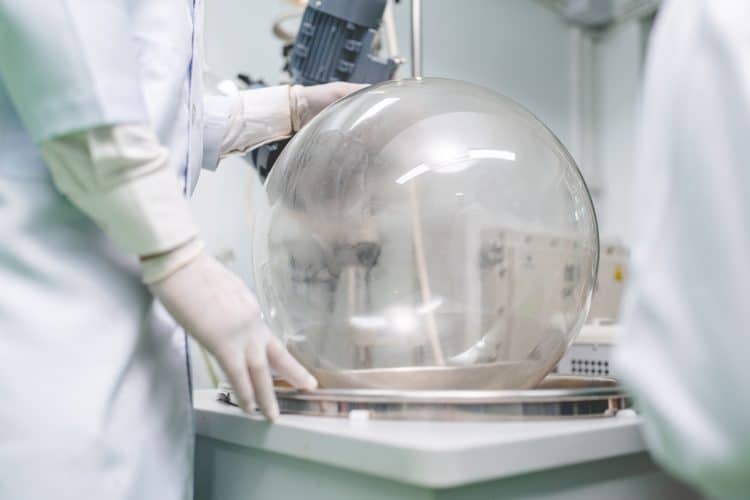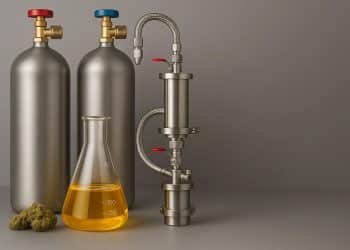Deep Eutectic Solvents (DES) and Natural Deep Eutectic Solvents (NADES) are new generation Ionic Liquids (IL), that can be described as a mixture of two or more solid organic or inorganic compounds which under optimal conditions (temperature and stirring time) liquefies and form stable eutectics. These tailor-made solvents are very interesting for the food, pharmaceutical and cosmetics industries.
Due to their adjustable physical-chemical properties and their green character it is expected that DES and NADES could be the most widely used solvents in the future, not only in extraction processes but also in other research areas.
Revolutionary paper in 2003 described the preparation of DES based on different quaternary salts in combination with zinc chloride. [1] Based on their outcomes this mixture had a melting point of 23-25°C and was confirmed the most promising. The results available so far are based on various instrumental analyzes (NMR, crystallographic data, fast atomic bomb mass spectrometry and Fourier) and show that DES components are held together by the formation of hydrogen bonds and Van der Waals forces. [2] [3]
When the DES forming components contain abundant cellular ingredients (sugars and organic acids) these mixtures are called Natural Deep Eutectic Solvents (NADES). [4]
The physical-chemical properties of DES/NADES depend on:
- the chemical properties of their starting compounds;
- molar ratio between the components;
- temperature;
- water addition.
The high viscosity of DES/NADES at room temperature (RT) is one of the main disadvantages of these solvents, which still limits their use in large industrial scale. [5]
Even if viscosities and densities can be significantly reduced by adding water, this process should be done with caution, as a large excess of water could break the hydrogen bonds between the components and thus lose the eutectic properties of the solvent produced. [6]
To produce tailor-made DES/NADES there are three methods that have been adopted and most frequently described: heating and stirring method [4], evaporation method [4] and freeze-drying method. [7]
Target Compounds
The secondary plant metabolites that cause pharmacological or toxicological effects in humans and animals are the bioactive compounds that the food, pharmaceutical and cosmetic industries are interested in. Product classes like terpenoids, alkaloids, sulfur and nitrogen-containing compounds and phenolic active ingredients (which are divided into several subclasses) are extraction targets.
Phenolic compounds have been recognized as excellent supplements in the production of functional foods and as substitutes for the synthetic additives used, due to their numerous beneficial effects on human health. Consequently, many studies have been conducted to optimize their extraction, however, due to their very different and complex structures, there is no universal method adopted for the extraction of all subclasses of plant polyphenols. [8]
It is worth noting that most DES/NADES used for the extraction of bioactive compounds are hydrophilic. This is not surprising considering the chemical properties of the target compounds.
However, some researches have recently, for the first time, introduced the use of tailor-made hydrophobic DES as extraction media for the isolation of various phyto-cannabinoids from Cannabis sativa L. [9]
Techniques and innovations
The extraction technique and the solvents used are the predominant factors in the efficiency of the process. But other variables such as the chemical and physical properties of the target compounds, extraction time, temperature, pH, and type of matrix also have an important influence. The main challenge in extraction is to achieve maximum utilization and repeatability of the process in the shortest possible time and with minimum use of energy and chemicals.
All extraction techniques can be divided into two main groups: conventional (classical) and modern extraction techniques:
Conventional techniques are Maceration (heating and stirring method) and Soxhlet that usually uses organic solvents. The extraction solvent, the solid/solvent ratio and the process temperature are the most important parameters when it comes to extraction efficiency. However, these conventional techniques have numerous drawbacks, the most important of which are: long extraction time, high extraction costs (associated with the use of large quantities of organic solvents and energy), non-selective extraction, possibility of degradation or isomerization of analytes due to prolonged heating, negative environmental effects and inappropriate recycling practices for the solvents used.
Some of these shortcomings can be eliminated by replacing them with simpler and more effective Modern Extraction Techniques: ultrasound-assisted extraction (UAE), microwave-assisted extraction (MAE), enzyme-assisted extraction (EAE), high intensity pulsed electric field (HIPEF), pressurized liquid extraction (PLE), etc. [10]
Innovative extraction techniques such as UAE and MAE are most used with DES/NADES solvents. UAE is based on the formation of high-frequency (20–1000 kHz) ultrasonic waves that cause cavitation due to the expansion and contraction cycles of the material improving the process efficiency. All advantages and benefits of the UAE technique for the extraction of bioactive compounds have already been described with the proven extractability of green DES/NADES for the various bioactive compounds and certainly represents a promising alternative to classical long-term extraction protocols. [11]
MAE uses frequencies of 0.3–300 GHz, the process can be performed in the “closed-vessel system” or “open-vessel system”. In both cases, the MAE system increases the temperature rapidly, resulting in shorter extraction time and a higher extraction yield of the target analytes. [12]
Application cases
One of the pioneer’s papers on this topic was published in 2016, in which the authors demonstrated a possible application of the UAE-DES for the extraction of phenolic compounds from grape skin. The predominant phenolic compounds in grape skin are anthocyanins, these actives can exist in different forms; at pH 1 (pH value of acidic-based DES) they are mainly present in the form of the red flavylium cation, while at higher pH (between 2 and 4) they are present as blue quinoidal species. The extraction efficiency of the proposed UAE-DES methodology was superior to both conventional and MAE extraction methods. [13]
Later, some researchers have proposed a UAE-DES one-step methodology for the simultaneous extraction and characterization of polar bioactive compounds and volatile monoterpenes from peppermint leaves. In this study choline chloride:glucose NADES was selected as the most promising solvent. From an economic and environmental point of view, the proposed method can probably only be used for the chemical characterization of peppermint samples of different origins, while the potential for introduction into large-scale processes is limited. [14]
The first research paper describing the use of DES in combination with MAE for the extraction of four major bioactive compounds of Radix scutellariae was presented in 2015. [15]
One year later, other researchers have described the MAE-DES methodology for the isolation of bioactive compounds from the Radix Salviae miltiorrhizae and have confirmed a statistically significant increase in extraction yields of five selected analytes compared to the results obtained by hot reflux extraction and UAE. [16]
In a recently published paper, a methodology based on MAE-DES pre-treatment in combination with microwave hydro-distillation of essential oils from cumin seed. Based on the results presented, the increased number of compounds was extracted after MAE-DES pre-treatment of the sample, resulting in an increase in the overall extraction yield. [17]
References
[1] Abbott, A.P.; Capper, G.; Davies, D.L.; Rasheed, R.K.; Tambyrajah, V. Novel Solvent Properties of Choline Chloride /Urea Mixtures. Chem. Commun. 2003.
[2] Choi, Y.H.; van Spronsen, J.; Dai, Y.; Verberne, M.; Hollmann, F.; Arends, I.W.C.E.; Witkamp, G.J.; Verpoorte, R. Are natural deep eutectic solvents the missing link in understanding cellular metabolism and physiology? Plant Physiol. 2011.
[3] Smith, E.L.; Abbott, A.P.; Ryder, K.S. Deep Eutectic Solvents (DESs) and Their Applications. Chem. Rev. 2014.
[4] Dai, Y.; van Spronsen, J.; Witkamp, G.J.; Verpoorte, R.; Choi, Y.H. Natural deep eutectic solvents as new potential media for green technology. Anal. Chim. Acta 2013.
[5] El Achkar T., Fourmentin S., Greige-Gerges H. Deep eutectic solvents: An overview on their interactions with water and biochemical compounds. J. Mol. Liq. 2019.
[6] Vilková M., Płotka-Wasylka J., Andruch V. The role of water in deep eutectic solvent-base extraction. J. Mol. Liq. 2020.
[7] Gutiérrez M.C., Ferrer M.L., Mateo C.R., Monte F. Del Freeze-drying of aqueous solutions of deep eutectic solvents: A suitable approach to deep eutectic suspensions of self-assembled structures. Langmuir. 2009.
[8] Ignat I., Volf I., Popa V.I. A critical review of methods for characterization of polyphenolic compounds in fruits and vegetables. Food Chem. 2011.
[9] Křížek T., Bursová M., Horsley R., Kuchař M., Tůma P., Čabala R., Hložek T. Menthol-based hydrophobic deep eutectic solvents: Towards greener and efficient extraction of phytocannabinoids. J. Clean. Prod. 2018.
[10] Ivanović M., Razboršek M.I., Kolar M., Innovative Extraction Techniques Using Deep Eutectic Solvents and Analytical Methods for the Isolation and Characterization of Natural Bioactive Compounds from Plant Material, Plants 2020, 9(11), 1428.
[11] Chemat F., Rombaut N., Sicaire A.G., Meullemiestre A., Fabiano-Tixier A.S., Abert-Vian M. Ultrasound assisted extraction of food and natural products. Mechanisms, techniques, combinations, protocols, and applications. A review. Ultrason. Sonochem. 2017.
[12] Ameer K., Shahbaz H.M., Kwon J.H. Green Extraction Methods for Polyphenols from Plant Matrices and Their Byproducts: A Review. Compr. Rev. Food Sci. Food Saf. 2017
[13] Cvjetko Bubalo M., Ćurko N., Tomašević M., Kovačević Ganić K., Radojcic Redovnikovic I. Green extraction of grape skin phenolics by using deep eutectic solvents. Food Chem. 2016
[14] Jeong K.M., Jin Y., Yoo D.E., Han S.Y., Kim E.M., Lee J. One-step sample preparation for convenient examination of volatile monoterpenes and phenolic compounds in peppermint leaves using deep eutectic solvents. Food Chem. 2018
[15] Wei Z.F., Wang X.Q., Peng X., Wang W., Zhao C.J., Zu Y.G., Fu Y.J. Fast and green extraction and separation of main bioactive flavonoids from Radix Scutellariae. Ind. Crops Prod. 2015.
[16] Chen J., Liu M., Wang Q., Du H., Zhang L. Deep eutectic Solvent-Based Microwave-Assisted method for extraction of hydrophilic and hydrophobic components from radix salviae miltiorrhizae. Molecules. 2016.
[17] Zhao Y., Wang P., Zheng W., Yu G., Li Z., She Y., Lee M. Three-stage microwave extraction of cumin (Cuminum cyminum L.) Seed essential oil with natural deep eutectic solvents. Ind. Crops Prod. 2019.












